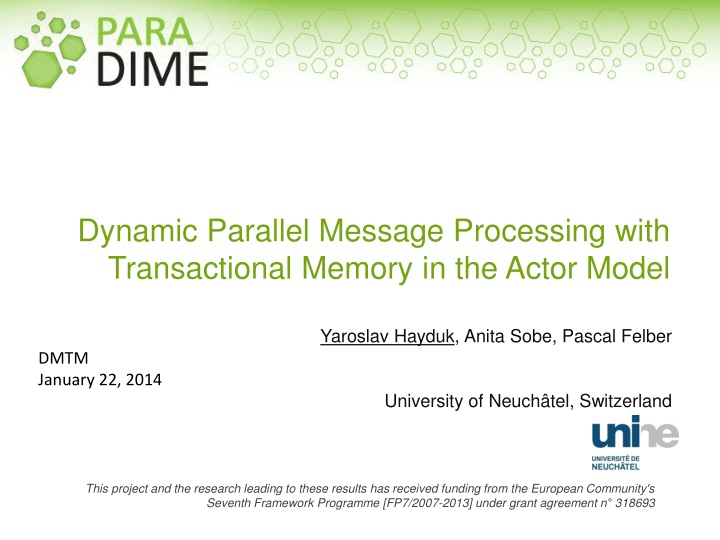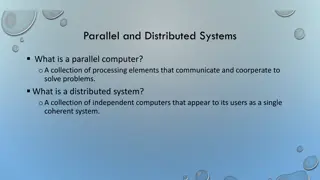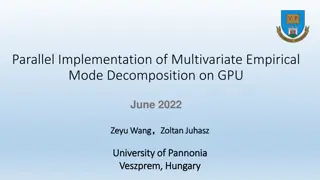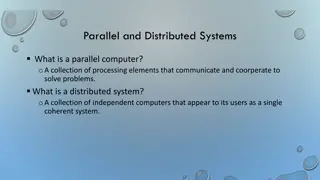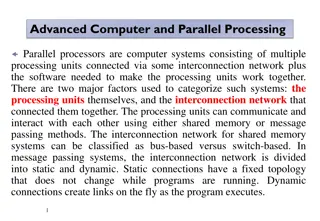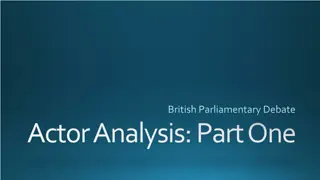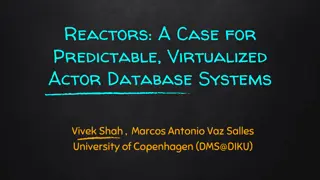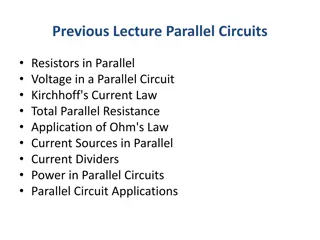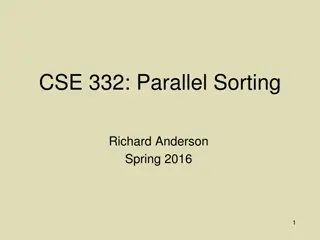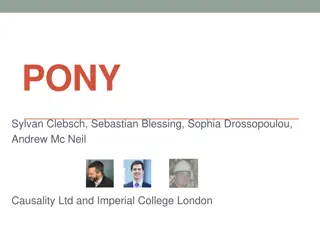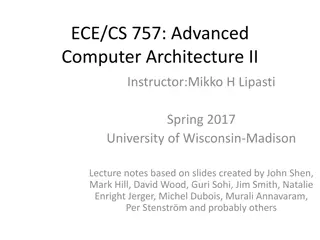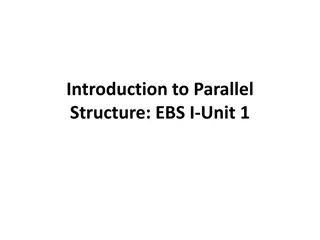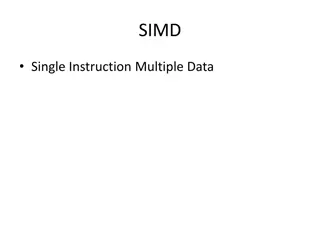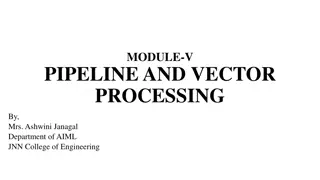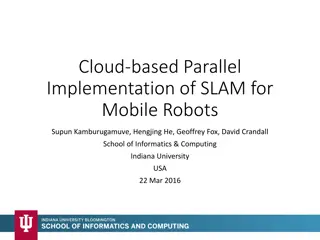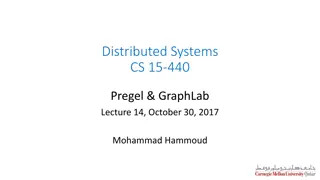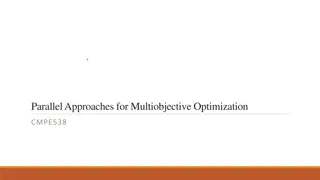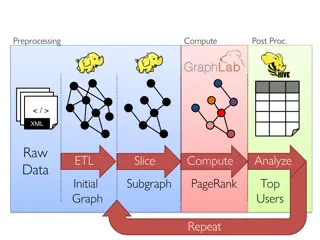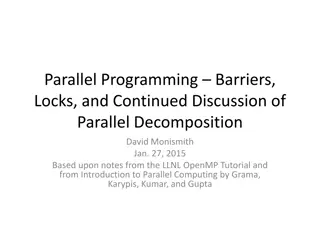Dynamic Parallel Message Processing with Actor Model
This project investigates dynamic parallel message processing with transactional memory in the actor model, addressing challenges of sequential processing limitations and contention issues. The proposed approach adapts thread numbers to workload, enhancing performance through optimized message handling. Actors in the model communicate asynchronously and encapsulate local state, promoting concurrency and efficient processing in highly parallel computing environments.
Uploaded on Feb 15, 2025 | 0 Views
Download Presentation

Please find below an Image/Link to download the presentation.
The content on the website is provided AS IS for your information and personal use only. It may not be sold, licensed, or shared on other websites without obtaining consent from the author.If you encounter any issues during the download, it is possible that the publisher has removed the file from their server.
You are allowed to download the files provided on this website for personal or commercial use, subject to the condition that they are used lawfully. All files are the property of their respective owners.
The content on the website is provided AS IS for your information and personal use only. It may not be sold, licensed, or shared on other websites without obtaining consent from the author.
E N D
Presentation Transcript
Dynamic Parallel Message Processing with Transactional Memory in the Actor Model Yaroslav Hayduk, Anita Sobe, Pascal Felber DMTM January 22, 2014 University of Neuch tel, Switzerland This project and the research leading to these results has received funding from the European Community's Seventh Framework Programme [FP7/2007-2013] under grant agreement n 318693
A bit of background: The Actor Model Hewitt & Baker (IFIP Congress 77) Laws for Communicating Parallel Processes Motivated by the prospect of highly parallel computing machines with many microprocessors + own local memory DMTM 2014. Yaroslav Hayduk, Anita Sobe, Pascal Felber 2
OOP and actors Everything is an actor (VS an object) Asynchronous message passing Has access to its local state only Strong encapsulation Inherently concurrent DMTM 2014. Yaroslav Hayduk, Anita Sobe, Pascal Felber 3
OOP and actors: Communication ObjectB.publicMethod() ObjectB.publicField=10 Object A Object B direct access Illegal: strong encapsulation VS ActorB.publicField = 10 ActorA [SendMessageTo] ActorB Object A Object A asynchronous message passing DMTM 2014. Yaroslav Hayduk, Anita Sobe, Pascal Felber 4
Problem statement Sequential processing of messages limits performance & throughput Concurrent message processing using STM (Hayduk et al., OPODIS 2013) is NOT optimal in cases of high contention DMTM 2014. Yaroslav Hayduk, Anita Sobe, Pascal Felber 5
Main contributions We propose to adapt the number of threads to the workload extract read-only messages from the transactional context DMTM 2014. Yaroslav Hayduk, Anita Sobe, Pascal Felber 6
Concurrent message processing Actor C ( List Actor) B Local Actor state Contains 2 2 5 6 8 9 In progress: Insert 8 In progress: Contains 8 Remove 9 Thread Pool A Active threads Problems in the case of high contention? DMTM 2014. Yaroslav Hayduk, Anita Sobe, Pascal Felber 7
Idea 1: Dynamically adjust the # of threads Actor C ( List Actor) B Local Actor state Contains 2 2 5 6 8 9 In progress: Insert 8 In progress: Contains 8 Remove 9 Thread Pool A Active threads Idle resources DMTM 2014. Yaroslav Hayduk, Anita Sobe, Pascal Felber 8
Idea 1: Dynamically adjust the # of threads Use a simple heuristic rollback# commit# Measure the rollback# commit# >a If decrease the thread count, otherwise increase it DMTM 2014. Yaroslav Hayduk, Anita Sobe, Pascal Felber 9
Idea 2: Use idle threads for relaxed operations Can we exploit the idle resources? Use them for specific read-only operations operations with relaxed atomicity and isolation semantics! DMTM 2014. Yaroslav Hayduk, Anita Sobe, Pascal Felber 10
Example: List Actor operations Actor Insert/ Remove/Contai ns Messages Very these depending on rollback# commit# private listData=Ref(data) Relaxed sum .. Messages DMTM 2014. Yaroslav Hayduk, Anita Sobe, Pascal Felber 11
Modified Scala STM Ref object methods: Ref get() . volatile protected_data relaxedGet() . Transaction Scopes: atomic{} atomic.unrecorded{} Our singleRelaxedGet() operation Since it s a write-back STM, we can safely access the value directly DMTM 2014. Yaroslav Hayduk, Anita Sobe, Pascal Felber 12
Idea 2: Use idle threads for relaxed consist. task Actor C ( List Actor) B Local Actor state Contains 2 2 5 6 8 9 In progress: Inconsistent Sum In progress: Contains 8 Remove 9 A Thread Pool Relaxed consist. Threads TM Threads DMTM 2014. Yaroslav Hayduk, Anita Sobe, Pascal Felber 13
Experimental settings Software: Scala 2.12 & Akka 2.10 & ScalaSTM 0.7 Hardware: 48-core AMD Opteron 6172 CPUs running at 2.1GHz DMTM 2014. Yaroslav Hayduk, Anita Sobe, Pascal Felber 14
Evaluation: Application overview 1) Stateful distributed sorted integer linked-list A List Range (100..125) Actor A List Range (1..25) Actor . Global relaxed list sum TM Insert/Remove/C ontains A B DMTM 2014. Yaroslav Hayduk, Anita Sobe, Pascal Felber 15
Evaluation: Application overview 2) Multiple-point geostatistics application (Hydra) When found, assign the value Z(y) to the simulation grid DMTM 2014. Yaroslav Hayduk, Anita Sobe, Pascal Felber 16
2) The Multiple-point geostatistics application Actor Simulation Messages private grid=Ref(data) Snapshot Messages DMTM 2014. Yaroslav Hayduk, Anita Sobe, Pascal Felber 17
Results list benchmark List write-dominated workload: static thread allocation. More write-write conflicts resolved by killing one txn more read-write conflicts, which are resolved by waiting List write-dominated workload: dynamic thread allocation. DMTM 2014. Yaroslav Hayduk, Anita Sobe, Pascal Felber 18
Results Hydra Static thread allocation; STM message throughput and total message throughput. Static ratio 3 Read-only threads 29 TM threads Dynamic thread allocation; STM message throughput and total message throughput. DMTM 2014. Yaroslav Hayduk, Anita Sobe, Pascal Felber 19
Results Hydra Simulation of the hydraulic subsurface: static and dynamic thread allocation; rollbacks. Static ratio 3 Read-only threads 29 TM threads Benefits of varying the TM thread count DMTM 2014. Yaroslav Hayduk, Anita Sobe, Pascal Felber 20
Summary By dynamically varying the number of threads, we increased the Actor message throughput; used idle resources for relaxed consistency operations; the combination of both approaches yields the best performance DMTM 2014. Yaroslav Hayduk, Anita Sobe, Pascal Felber 21
Questions? DMTM 2014. Yaroslav Hayduk, Anita Sobe, Pascal Felber 22
